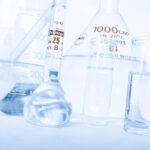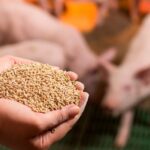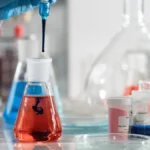The NORBIDAR project represents a cutting-edge leap in the biosynthesis raw material industry, combining advanced process design with strong environmental protection measures. This blog post will introduce the project’s innovative process layout, environmental technologies, advanced manufacturing techniques, and automation control systems, showcasing how NORBIDAR leads the way in green manufacturing.
Optimized Spatial Layout for Efficient and Safe Production
The entire NORBIDAR production facility is newly constructed, featuring a four-story standardized workshop designed with a vertical, layered equipment layout. This design follows the principle of “Three Modernizations and One Excellence” (standardization, automation, integration, and excellence).
- Top Floor: Raw material feeding and reaction units are located here.
- Middle Floors: Separation equipment is installed below the reaction units.
- Bottom Floor: Drying and packaging equipment are placed at the lowest level.
This vertical arrangement maximizes the use of gravity flow for material transfer, minimizing manual handling and open transfers. For liquid materials that cannot use gravity flow, diaphragm pumps with positive pressure are employed to ensure sealed and safe transfer.
The equipment selection emphasizes high integration and automation to eliminate potential pollution sources, enhance product safety, and stabilize quality throughout the production process.
Environmental Advanced Features
NORBIDAR’s green manufacturing approach is evident in every stage of material handling and processing:
1. Liquid Material Transport and Measurement
- Liquid raw materials stored in tanks are transported using screw pumps and diaphragm pumps in a fully sealed manner.
- Barrel-stored liquids are handled in closed feeding rooms.
- All liquid raw materials and intermediates move through sealed, metered pipelines.
- Transfer between reactors and tanks is pipeline-based and enclosed, achieving near-complete pipeline and sealed production in the workshop.
2. Solid Material Transport and Measurement
- Solid materials are weighed in dedicated weighing rooms equipped with ventilation and dust removal systems, maintaining a slightly negative pressure to prevent dust escape.
- Depending on material characteristics, packaging, and feed volume, different feeding methods are used to reduce unorganized emissions:
- Closed feeding silos.
- Solid feeders for small packaged materials.
3. Main Reaction Units
- Reactors operate under slight negative pressure with micro-pressure one-way valves.
- Pressure is precisely controlled via a Distributed Control System (DCS), reducing waste gas emissions.
- Online sampling systems avoid uncontrolled emissions during sampling.
4. Solid-Liquid Separation Units
- Separation steps that generate waste gas use highly automated, sealed centrifuges.
- Exhaust gases are collected and treated in dedicated waste gas systems.
5. Drying and Finished Product Packaging
- Drying occurs in sealed equipment using energy-efficient, low-labor-intensity technologies chosen based on material properties.
- Materials enter and exit drying equipment through sealed pipelines.
- Drying exhaust is treated before discharge.
- Packaging is performed in separate rooms with automated packaging machines, and packaging waste gas is collected and treated.
6. Unloading and Discharge Units
- Gas-phase balance pipes and induced draft systems are installed between reactors, separation equipment, and intermediate tanks.
- Waste and filter cake discharge areas have dedicated rooms with exhaust gas collection and treatment.
Advanced Process Technologies
1. Enzymatic Catalysis for Algal Oil Transesterification
Unlike traditional acid or alkali catalysis that requires high temperature (80-100°C) and pressure, NORBIDAR uses enzyme catalysis under mild conditions (40-50°C, atmospheric pressure). This avoids side reactions like isomerization and equipment corrosion. The continuous production concept reduces the amount of material in reaction at any time, enhancing safety and product quality while lowering equipment demands.
2. Continuous Production of Fumaric Acid
The project uses a continuous feed and discharge process for fumaric acid production from maleic anhydride. This contrasts with conventional batch processes that suffer from concentrated heat release and difficult heat transfer. The continuous process ensures uniform heat release, easier heat management, lower safety risks, and more stable product quality.
3. Physical Separation and Purification
Separation and purification rely solely on physical methods based on differences in boiling points and polarity, avoiding chemical reactions. These mature technologies are widely applied in similar projects with proven effectiveness.
4. Low-Temperature Drying
The drying section employs low-temperature drying methods, reducing energy consumption by about 50% compared to traditional fluidized bed drying, contributing significantly to energy savings.
Automation and Safety Control
The entire production process is monitored and controlled by a Distributed Control System (DCS), especially for key and high-risk units involving hazardous materials. This system enhances process monitoring and automation, reducing manual intervention.
- An Emergency Shutdown System (ESD) is in place for rapid response.
- Safety Instrumented Systems (SIS) are designed based on Layer of Protection Analysis (LOPA) and Safety Integrity Level (SIL) assessments, ensuring safe operation.
- The combination of DCS, SIS, and sealed automated operations significantly raises safety and environmental protection standards.
Conclusion
The NORBIDAR biosynthesis raw material R&D and industrial green manufacturing project sets a new benchmark in sustainable chemical production. Through optimized spatial layout, advanced environmental protection technologies, innovative enzymatic and continuous processes, energy-efficient drying, and sophisticated automation, the project achieves:
- High safety and product quality
- Minimal environmental impact
- Reduced energy consumption
- Enhanced operational efficiency
NORBIDAR exemplifies how modern green manufacturing can harmonize industrial development with environmental stewardship, paving the way for a cleaner, safer chemical industry future.




